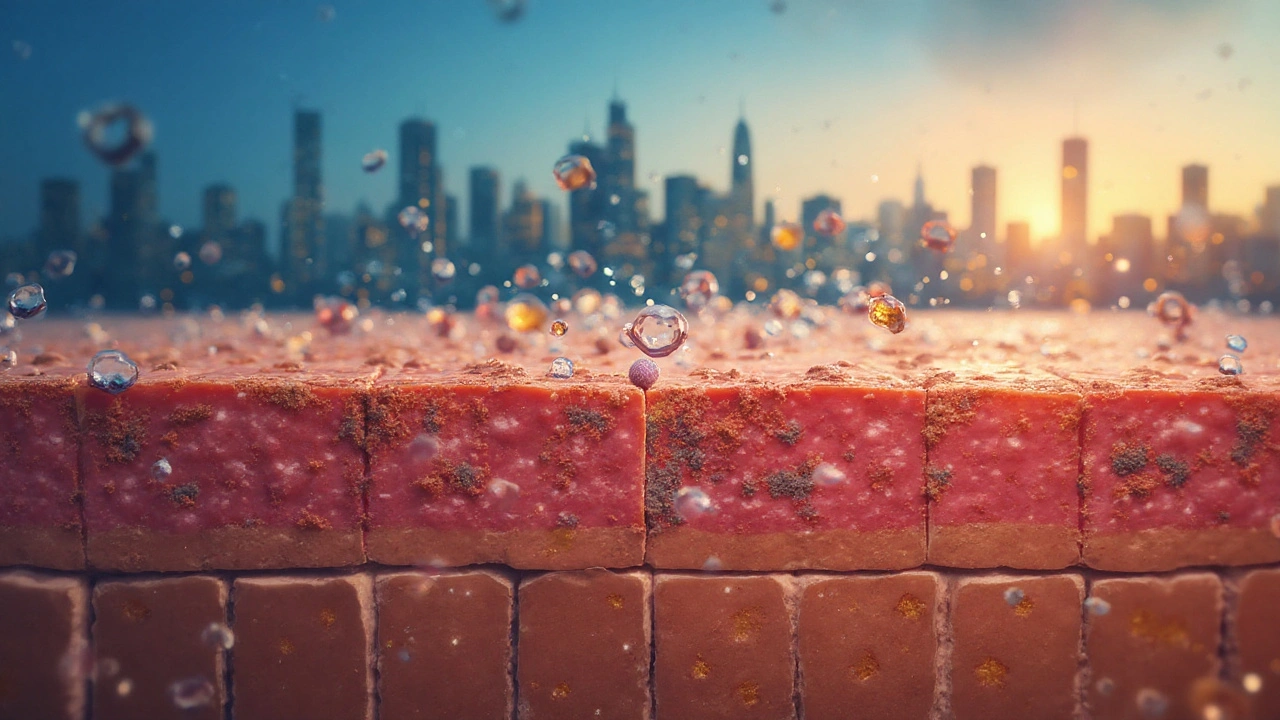22 Sep 2025
- 11 Comments
Skin Barrier Health is a set of functions that keep the outermost layer of the skin intact, limit water loss, and block external irritants. When this protective shield falters, melasma‑triggering factors slip through more easily, leading to stubborn brown patches. Understanding how the barrier works gives you a powerful weapon in the battle against hyperpigmentation.
Key Takeaways
- The skin barrier regulates moisture and blocks UV‑induced pigment triggers.
- Stratum corneum integrity and low transepidermal water loss (TEWL) are essential for melasma prevention.
- Ceramides, niacinamide, and hyaluronic acid are the three most effective barrier‑repair ingredients.
- Daily habits like sunscreen, gentle cleansing, and targeted moisturizers keep the barrier resilient.
- Addressing hormonal and genetic predispositions works best when the barrier is strong.
What Is Melasma?
Melasma is a chronic skin condition characterized by symmetrical brown‑gray patches, typically on the face. It’s driven by melanin overproduction, which can be sparked by UV exposure, hormonal fluctuations, and inflammation. While many treatments target the pigment itself, the underlying barrier condition often decides whether a spot clears or returns.
The Skin Barrier’s Role in Pigmentation
At the heart of the barrier lies the Stratum Corneum is a thin, dead‑cell layer that functions like a brick‑mortar wall - corneocytes are the bricks, lipids the mortar. When the mortar cracks, water evaporates, and external aggressors, including UV‑induced reactive oxygen species, reach the living layers beneath. This breach raises Transepidermal Water Loss (TEWL) is a measure of how much water escapes through the skin, a reliable sign that the barrier is compromised.
High TEWL means the skin is dry and inflamed, both of which stimulate melanocytes to dump more melanin. Conversely, a low TEWL environment keeps keratinocytes calm, reduces inflammation, and makes UV‑induced pigment spikes less likely. In short, barrier integrity and melasma are tightly linked.
Key Ingredients that Strengthen the Barrier
Research from dermatology institutes in Sydney, London, and Seoul consistently highlights three actives that restore lipid balance, boost moisture, and calm inflammation.
| Ingredient | Primary Function | Typical Concentration | Best For |
|---|---|---|---|
| Ceramides skin‑lipid molecules that rebuild the mortar | Restores lipid matrix, reduces TEWL | 1-3% | Dry or eczema‑prone skin |
| Niacinamide a form of vitaminB3 that improves barrier proteins | Boosts ceramide synthesis, evens tone | 2-5% | All skin types, especially oily |
| Hyaluronic Acid a humectant that draws water into the stratum corneum | Increases hydration, supports barrier repair | 0.5-2% | Sensitive or dehydrated skin |
Using a moisturizer that blends these three gives a synergistic effect: ceramides seal the wall, niacinamide reinforces the bricks, and hyaluronic acid keeps the mortar moist.

Daily Habits to Protect the Barrier
Even the best serum can’t rescue a barrier that’s constantly under attack. Here are the habits that keep the wall strong:
- UV Radiation is a range of sunlight wavelengths that damage DNA and trigger oxidative stress. Apply a broad‑spectrum sunscreen (SPF30+, UVA‑PF≥15) every morning, even on cloudy days.
- Swap harsh foaming cleansers for low‑pH, sulfate‑free formulas that respect the lipid layer.
- Layer a barrier‑repair moisturizer within two minutes of cleansing while the skin is still damp to lock in moisture.
- Limit exfoliation to 1-2 times per week; over‑exfoliating strips away the very lipids you’re trying to protect.
- Stay hydrated internally - aim for 2liters of water daily - because systemic dehydration reflects on TEWL values.
Building a Melasma Prevention Routine
Putting the pieces together into a daily schedule makes adherence easier. Follow the three‑step routine below:
- Morning Cleanse & Protect
- Use a gentle, pH‑balanced cleanser (e.g., micellar water or a cream cleanser).
- Pat skin dry, then apply a serum containing niacinamide (2-5%).
- Finish with a moisturizer featuring ceramides and hyaluronic acid, followed by broad‑spectrum sunscreen.
- Midday Boost
- If you’re outdoors, reapply sunscreen every 2hours.
- Consider a lightweight mist with hyaluronic acid to top‑up hydration.
- Evening Repair
- Cleanse again, this time with a slightly richer balm if your skin feels tight.
- Apply a barrier‑repair cream (ceramides+niacinamide) before bedtime.
Consistency is key - the barrier takes weeks to rebuild, but once strong, melasma flare‑ups become far less frequent.
Common Mistakes and How to Fix Them
Even well‑intentioned skincare can backfire if you ignore barrier cues.
- Skipping sunscreen because you’re indoors. Indoor lighting still emits UVA, which penetrates windows and can worsen melasma. Keep sunscreen on your desk for quick touch‑ups.
- Using high‑strength acids on compromised skin. Glycolic or salicylic acids increase TEWL when the barrier is weak. Switch to mild AHA (≤5%) or pause acids until the barrier recovers.
- Choosing “oil‑free” moisturizers that contain only water. Oil‑free often means lipid‑free, leaving the mortar without repair material. Look for moisturizers that list ceramides or fatty acids near the top of the ingredient list.
Related Concepts Worth Exploring
Once your barrier is back on track, you may want to dig deeper into the following topics, which sit in the same knowledge cluster:
- Hormonal Factors - how pregnancy, oral contraceptives, and thyroid imbalances amplify melasma risk.
- Genetic Predisposition - why certain ethnicities experience higher melasma prevalence.
- Skin Type Assessment - tailoring barrier‑care to oily, combination, or sensitive skin.
- Antioxidant Therapies - the role of vitaminC, ferulic acid, and resveratrol in neutralising UV‑induced free radicals.
Each of these expands the conversation beyond the barrier, but they all perform best when the foundation is solid.

Frequently Asked Questions
Can a damaged skin barrier cause melasma to return?
Yes. When the barrier is compromised, more UV‑induced reactive oxygen species reach melanocytes, triggering melanin overproduction. Restoring the barrier lowers the chance of recurrent spots.
How long does it take to see barrier improvement?
Most people notice reduced dryness and lower TEWL within 2-4weeks of consistent ceramide‑rich moisturization. Visible melasma fading may take 8-12weeks because pigment turnover is slower.
Is sunscreen enough to prevent melasma?
Sunscreen is essential but not sufficient on its own. A strong barrier limits UV penetration, while antioxidants and barrier‑repair actives address inflammation that also fuels melasma.
Should I use exfoliants if I have melasma?
Gentle, low‑pH exfoliants (like lactic acid 5% or enzyme masks) can improve texture without harming the barrier, but avoid aggressive scrubs or high‑strength acids until the barrier is fully repaired.
Do diet and hydration affect the skin barrier?
Absolutely. Omega‑3 fatty acids, zinc, and adequate water intake support lipid synthesis and reduce TEWL, making the barrier more resilient against melasma triggers.


Avis Gilmer-McAlexander
September 22, 2025Okay but can we talk about how the barrier is basically your skin’s BFF who shows up even when you’ve been neglecting it? I used to think melasma was just ‘bad luck’ until I started layering ceramides like they were armor. Now my patches are fading and my skin actually feels like skin again, not a desert. Also, hyaluronic acid on damp skin? Game changer. I cry happy tears every morning now.
Jerry Erot
September 23, 2025Actually, the article oversimplifies. TEWL isn’t just about ceramides - it’s about lipid bilayer organization, which requires specific fatty acid ratios like C24:0 and C26:0, not just ‘ceramides’ as a magic bullet. Also, niacinamide’s effect on melanin is dose-dependent and only works if you’re not using it with vitamin C, which antagonizes it. Most people don’t know this because big brands don’t want you to.
Fay naf
September 24, 2025Let’s be real - if you’re still using hyaluronic acid without a lipid barrier to lock it in, you’re just giving your skin a dehydration party. HA is a siren song for the uninformed. It draws water from the dermis if the stratum corneum is compromised. So you’re basically trading one problem for another. And sunscreen? Please. SPF 30 is a joke if you’re not reapplying every 90 minutes and even then, UVA1 still sneaks through. You need zinc oxide. Period. No debate.
ANTHONY SANCHEZ RAMOS
September 26, 2025OMG YES THIS!! 🙌 I was skeptical but after 3 weeks of ceramides + niacinamide + sunscreen EVERY. SINGLE. DAY. (even when I just sat inside 😅) my melasma started fading?? Like, actually fading?? My dermatologist was shocked. Also, I switched to a cream cleanser and my face stopped feeling like sandpaper?? Best decision ever. If you’re reading this and still using foaming cleansers… please stop. Your skin will thank you. And yes, hydration matters - I drink 3L now. No joke.
Matt Czyzewski
September 27, 2025There is an ontological dimension to skin barrier integrity that transcends mere biochemistry. The stratum corneum, as a boundary between self and environment, mirrors the psychological thresholds we erect in daily life - fragility, resilience, permeability. When we neglect our barrier, we are not merely failing to moisturize; we are surrendering our epidermal sovereignty to entropy. The act of applying ceramides becomes a ritual of self-reclamation. One might argue that melasma is not merely pigment, but the visible echo of systemic neglect - a somatic manifestation of emotional and environmental dissonance.
John Schmidt
September 28, 2025Ugh I tried all that stuff and it made my skin worse. Like, I used ceramides and niacinamide and guess what? My face turned into a red, flaky mess. So maybe this whole ‘barrier repair’ thing is just a marketing scam? I think melasma is mostly hormonal and people are just blaming their skincare because they don’t want to admit they’re on birth control or something. Also, sunscreen? I wear a hat. That’s enough. Stop pushing products.
Harrison Dearing
September 29, 2025People keep saying ‘ceramides fix everything’ but have you checked the actual formulation? Most ‘ceramide’ creams have 0.1% and call it a day. Real barrier repair needs 3% minimum, and even then, it’s useless if the pH is 6.5+. Your skin’s pH is 4.5–5.5. If your product doesn’t say pH on the bottle, it’s probably garbage. Also, stop using ‘natural’ oils. Coconut oil is comedogenic and increases TEWL. Just say no.
Justice Ward
October 1, 2025I’ve been dealing with melasma since my second kid. I tried lasers, hydroquinone, everything. Nothing stuck until I stopped fighting my skin and started nurturing it. The ceramide moisturizer I use? It’s cheap as hell, no brand name. Just ingredients I can pronounce. And I stopped scrubbing. Just… gently patting. It’s wild how much less angry my skin looks now. Not perfect, but peaceful. That’s the win.
bhuvanesh kankani
October 2, 2025In India, we have a traditional remedy called ‘kasturi manjal’ (turmeric mixed with milk) used for centuries to calm pigmentation. While modern science validates ceramides and niacinamide, I find that combining gentle Ayurvedic practices - like using rosewater as a toner and avoiding excessive heat exposure - complements the barrier repair approach beautifully. The key is balance, not aggression. Skin is not a battlefield; it is a garden.
maria norman
October 3, 2025Wow. So the ‘complete guide’ is just a 12-step program sold by a brand that sells ceramides. And you didn’t mention that melasma is 90% hormonal? That’s like saying ‘how to fix a leaky roof by painting the walls.’ But hey, at least you got me to buy a $78 moisturizer. Thanks for the guilt trip.
Iris Schaper
October 5, 2025One sentence: I used to think I needed to ‘fix’ my skin, but now I just let it rest. No acids. No serums. Just water, a ceramide cream, and sunscreen. Melasma didn’t vanish overnight. But it stopped getting worse. And that’s more than I’ve had in 5 years.